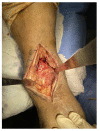Iatrogenic Ankle Charcot Neuropathic Arthropathy after Spinal Surgery: A Case Report and Literature Review
- PMID: 36556978
- PMCID: PMC9785748
- DOI: 10.3390/medicina58121776
Iatrogenic Ankle Charcot Neuropathic Arthropathy after Spinal Surgery: A Case Report and Literature Review
Abstract
Charcot neuropathic arthropathy is a relatively rare, chronic disease that leads to joint destruction and reduced quality of life of patients. Early diagnosis of Charcot arthropathy is essential for a good outcome. However, the diagnosis is often based on the clinical course and longitudinal follow-up of patients is required. Charcot arthropathy is suspected in patients with suggestive symptoms and an underlying etiology. Failed spinal surgery is not a known cause of Charcot arthropathy. Herein we report a patient with ankle Charcot neuropathic arthropathy that developed after failed spinal surgery. A 58-year-old man presented to the emergency room due to painful swelling of the left ankle for 2 weeks that developed spontaneously. He underwent spinal surgery 8 years ago that was associated with nerve damage, which led to weakness of great toe extension and ankle dorsiflexion, and sensory loss below the knee. CT and T2-weighted sagittal MRI showed a fine erosive lesion, subluxation, sclerosis, fragmentation, and large bone defects. Based on the patient's history and radiological findings, Charcot arthropathy was diagnosed. However, the abnormal blood parameters, positive blood cultures, and severe pain despite the decreased sensation suggested a diagnosis of septic arthritis. Therefore, diagnostic arthroscopy was performed. The ankle joint exhibited continued destruction after the initial surgery. Consequently, several repeat surgeries were performed over the next 2 years. Despite the early diagnosis and treatment of Charcot arthropathy, the destruction of the ankle joint continued. Given the chronic disease course and poor prognosis of Charcot arthropathy, it is essential to consider this diagnosis in patients with neuropathy.
Keywords: ankle; charcot neuropathic arthropathy; iatrogenic charcot; spinal surgery.
Conflict of interest statement
The authors declare that they have no conflict of interest.
Figures








Similar articles
-
Multi-joint Charcot arthropathy caused by cervical spondylotic myelopathy and adult degenerative scoliosis with syringomyelia: a case report.Br J Neurosurg. 2023 Dec;37(6):1843-1849. doi: 10.1080/02688697.2021.1940861. Epub 2021 Jun 29. Br J Neurosurg. 2023. PMID: 34184598
-
Charcot arthropathy of the foot and ankle associated with rheumatoid arthritis.Foot Ankle Int. 2013 Nov;34(11):1541-7. doi: 10.1177/1071100713500490. Epub 2013 Jul 30. Foot Ankle Int. 2013. PMID: 23900228
-
Posttraumatic Charcot (Neuropathic) Spinal Arthropathy at the Cervicothoracic Junction.World Neurosurg. 2016 Oct;94:580.e1-580.e4. doi: 10.1016/j.wneu.2016.07.064. Epub 2016 Jul 26. World Neurosurg. 2016. PMID: 27474457
-
Case report: Neuropathic arthropathy of the hip as a sequela of undiagnosed tertiary syphilis.Clin Orthop Relat Res. 2010 Nov;468(11):3126-31. doi: 10.1007/s11999-010-1257-0. Epub 2010 Feb 12. Clin Orthop Relat Res. 2010. PMID: 20151233 Free PMC article. Review.
-
Recognition and management of acute neuropathic (Charcot) arthropathies of the foot and ankle.J Orthop Sports Phys Ther. 1999 Dec;29(12):736-46. doi: 10.2519/jospt.1999.29.12.736. J Orthop Sports Phys Ther. 1999. PMID: 10612071 Review.
Cited by
-
Spectrum of neuropathic skeletal injuries in children: a pictorial essay.Insights Imaging. 2025 Mar 7;16(1):54. doi: 10.1186/s13244-025-01920-y. Insights Imaging. 2025. PMID: 40055200 Free PMC article.
-
Charcot arthropathy of the knee accompanied by tethered cord syndrome and lumbosacral fur sinus.Heliyon. 2024 Jun 8;10(12):e32754. doi: 10.1016/j.heliyon.2024.e32754. eCollection 2024 Jun 30. Heliyon. 2024. PMID: 38952367 Free PMC article.
References
-
- Eichenholtz S.N. Charcot joints. J. Bone Jt. Surg. 1962;44:1485.
Publication types
MeSH terms
Grants and funding
LinkOut - more resources
Full Text Sources
Medical

